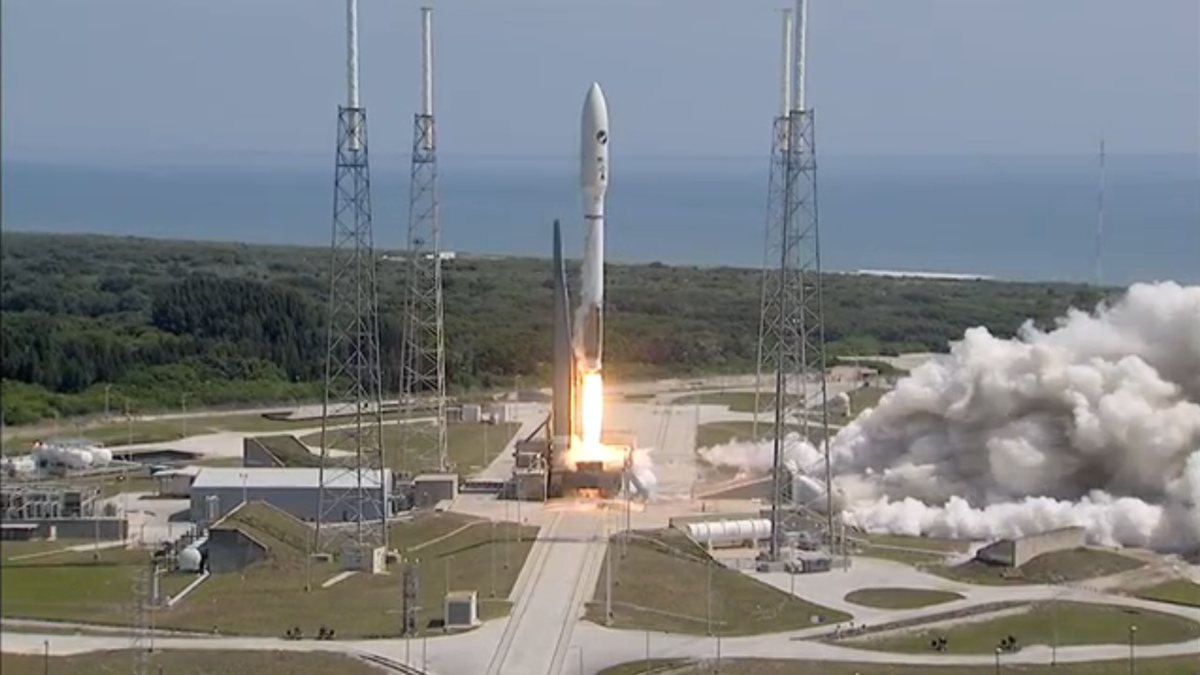
The U.S. Air Force's X-37B space plane launched on another mystery mission, Russia's Proton rocket failed during a satellite launch and astronomers found the most luminous galaxy in the universe. Here's a look at Space.com's top stories of the week.
Mysterious X-37B military space plane launches again
The U.S. Air Force's robotic X-37B soared into orbit on its fourth mystery mission Wednesday (May 20) in a launch that also lofted the Planetary Society's LightSail solar-sailing craft. [Full Story: US Air Force Launches X-37B Space Plane on 4th Mystery Mission]
Another Russian rocket failure
A Russian-built Proton rocket failed during a communications satellite launch over the weekend, dealing another blow to the nation's space program. [Full Story: Russian Proton Rocket Fails During Satellite Launch]
Astronomers find the most luminous galaxy in the universe
A newfound galaxy is the most luminous one known in the universe, blazing more brightly than 300 trillion suns. [Full Story: Brightest Galaxy in Universe Found]
Get the Space.com Newsletter
Breaking space news, the latest updates on rocket launches, skywatching events and more!
25th anniversary of Hubble's first photo
NASA's Hubble Space Telescope may have launched 25 years ago last month, but Wednesday (May 20) marked another big anniversary for the famous observatory — a quarter-century since it took its first photo. [Full Story: Hubble Telescope Opened Its Space Eyes 25 Years Ago Today (Photo)]
2013 Chinese rocket launch may have been anti-satellite test
The U.S. Defense Department is suggesting that the May 2013 launch of a Chinese rocket that it branded at the time as suspicious was a test of a technology designed to counter or destroy satellites in geosynchronous orbit. [Full Story: Pentagon Says 2013 Chinese Launch May Have Tested Antisatellite Technology]
Another 'golden record?'
NASA's New Horizons Pluto probe may end up with one final mission after its work exploring the outer solar system is done — carrying a message to advanced alien civilizations. [Full Story: NASA Pluto Probe May Carry Crowdsourced Message to Aliens]
Solar-sailing cubesat's orbital trial set to begin
The nonprofit Planetary Society's LightSail spacecraft, which launched Wednesday (May 21), will conduct an orbital test mission that aims to help pave the way for future solar-sailing vessels. [Full Story: Tiny Solar Sail 'Cubesat' Launching with X-37B Space Plane on Wednesday]
Rosetta sees 'balancing rocks' on comet
The European Space Agency's Rosetta spacecraft spotted three boulders, each balancing on a small contact area, on the surface of Comet 67P/Churyumov-Gerasimenko. [Full Story: On Comet, 'Ballerina' Rocks Perform Balancing Act (Photos)]
Space weather and alien life
Earth regularly endures violent ejections of material from the sun, but could similar eruptions in other solar systems make alien planets inhospitable to life? [Full Story: Wild Weather of Distant Stars May Affect Chances for Alien Life]
New insights into supernovas
Debris blown off a dying star collided with its companion, creating a blast of ultraviolet radiation that is helping scientists to better understand the evolution of one of the key tools to measure the expansion of the universe. [Full Story: Rare Supernova Burst Shines Light on Its Mysterious Origins]
Dragon returns to Earth
SpaceX's robotic Dragon capsule returned to Earth Thursday (May 21), wrapping up the private spaceflight company's sixth cargo mission to the International Space Station. [Full Story: SpaceX Dragon Cargo Capsule Splashes Down in Pacific Ocean]
Follow Mike Wall on Twitter @michaeldwall and Google+. Follow us @Spacedotcom, Facebook or Google+.
Join our Space Forums to keep talking space on the latest missions, night sky and more! And if you have a news tip, correction or comment, let us know at: community@space.com.

Michael Wall is a Senior Space Writer with Space.com and joined the team in 2010. He primarily covers exoplanets, spaceflight and military space, but has been known to dabble in the space art beat. His book about the search for alien life, "Out There," was published on Nov. 13, 2018. Before becoming a science writer, Michael worked as a herpetologist and wildlife biologist. He has a Ph.D. in evolutionary biology from the University of Sydney, Australia, a bachelor's degree from the University of Arizona, and a graduate certificate in science writing from the University of California, Santa Cruz. To find out what his latest project is, you can follow Michael on Twitter.
